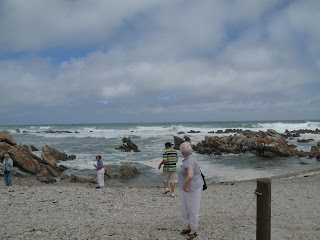
Sunday, February 13, 2011
As we drive along the mountain roads full of abrupt serpentinesI admire the talent and expertise of the engineers who built these roads. They are safe enough for people to built their homes overlooking and abyss. There is even a high school . I wonder how could the students concentrate on their work while faced with what Francis Drake described as "the most beautiful
Cape in the whole circumferance of the globe."
"



The visit to the penguin colony offers a perfect contrast to the majesty of the Cape. The birds are -of course- adorable as they sit on the stony beach. They are very still as if posing for photographs.
We then visit a -so called- botanical gardens; it is more like a park, with a mountain in the background and plants on steep levels, which we are invited to climb. This is a strenous tour; I try to close my eyes and rest on the way back but the driver shakes me to wake me up . Really!










